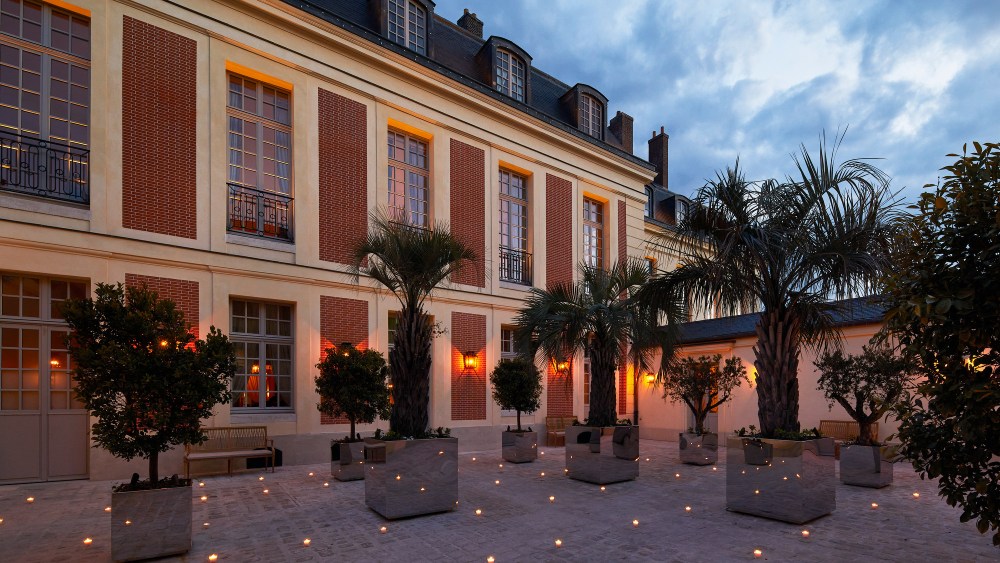Picture this: as your carriage rolls along in the late afternoon, the Château de Versailles comes into view.
A modest hunting lodge under King Louis XIII, the architectural crown jewel of France’s royalty has been greatly expanded and embellished since his successor Louis XIV, also known as the Sun King, came into full power in 1661.
But there isn’t much time to admire its facades turning golden with the sunset or the expansive gardens as you pull up to the side of the royal complex, where stands a fine building designed by the Sun King’s favorite architect in 1681.
After alighting, a name — one discovered in a wax-sealed envelope upon entrance — is announced by the liveried butler as you are ushered into the Salon d’Audience reception room bathed in flickering candlelight.
You May Also Like
Except that you aren’t in the early 1700s and it’s not ministers of the French kings’ courts or the intellectual elite of the Age of Enlightenment who await inside this building appointed in the grandest 18th-century style and filled with precious antiques.
It’s over three centuries later and you’re here for The Grand Banquet, an immersive Michelin-star experience imagined by chef Alain Ducasse at Airelles Château de Versailles, Le Grand Contrôle, a sumptuous 13-key hotel that opened in 2021 and the only one set in the boundaries of the palace.
Paramount at Le Grand Contrôle is the culinary experience, helmed by Ducasse, the only chef to tally 21 Michelin stars across his constellation of establishments around the world.
While the dinners of the Sun King were more spectacle than meal for anyone but the direct royal family — the court watched the proceedings from seats, if they were lucky, or stood throughout — this feast is squarely for today’s epicureans.
For Ducasse, the throughline of The Grand Banquet is answering one question: “What and how would the royal court eat today?”
Forget recreating dishes eaten three centuries ago. “We rather invent a contemporary version of the ancient royal dinners: how they would have evolved along the time until today,” he tells WWD Weekend.
“Our menu is built on the same structure than the ancient one — with eight services including ‘Relevé’ [a fish or meat dish], ‘Rôst’ [a poultry-based or feathered game roast], ‘Entremets’ [or sweets and desserts],” he continues. “But culinary techniques and tastes are quite modern, with exceptional, seasonal produce.”
Further building the ambience are candlelit crystal chandeliers, dramatic floral arrangements and tables set with 18th-century tableware in the painstakingly restored salons that overlook the gardens of Versailles.
The flow of canapés and cheese gougères and Champagne served by the carafe is interrupted only by the shout of “Au couvert du roi,” (or “to the king’s table,” in English). Guests are then led to their tables before a ballet of domed dishes begins, each revealing tantalizing fare.
At Thanksgiving, that meant butternut and Paris mushroom tourts, a stuffed turkey with mashed chestnuts and the pecan pie, all given that Ducasse touch.
For spring, the kitchens will be working with langoustines, fennel, green asparagus and milk-fed lamb, among other seasonal produce. And no meal is complete without a touch of chocolate from Ducasse’s famed kitchen.
Congruent with today’s clientele, the menu can be paired with either nonalcoholic beverages for 430 euros, while sampling wines and Champagne will set visitors back 620 euros.
Punctuating the dinner are artistic performances that include the description of dishes peppered with facts about royal habits, produce or historical anecdotes.
Did you know that green peas were Louis XIV’s favorite vegetable and that courtesans would hide them everywhere on their person so they could offer them to the king? Or that the “service à la française,” or French-style service of dishes made to be shared and placed simultaneously on the table, was invented by Louis XV?
While the historical element looms large by virtue of the setting and offers a novel twist on Michelin-starred fine dining, it should only be seen as cultural condiment.
“We are not doing a historical reconstitution,” says the hotel’s general manager Julien Révah. “What we want to do here is offer an experience that transports clients to the 18th century, not just offer magnificent rooms or fine dining, and excel in the experience.”
In addition to Ducasse’s culinary mastery, offering a cohesive experience that encompasses the liveried staff in period costumes and the ceremonial is part and parcel of the success of the banquet, according to Révah.
“Imagine for one second this kind of experience with maître d’ and waiters in black [contemporary suiting] attire — it wouldn’t fit and would look ridiculous,” he says. “Offering a moment as it was lived in the 18th century is like watching classical theater. What you might find jarring is anachronistic elements.”
With 80 percent of hotel guests availing themselves of the dinner — banquet or nightly feast — Révah said it had become a must-do that is integral to the experience of the hotel.
Since it launched in 2024, some guests have attended two out of the four sessions offered so far. Serving as the introduction to the seasonal menu, the next session is slated for three evenings starting March 21.
The aim is also to draw a new clientele, one who isn’t necessarily going to spend a night (or several) in the rooms and suites overlooking the Orangerie of Versailles, Révah said. Currently, the proportion of nonresidents sits between 20 and 30 percent, a share he hopes to grow as word of the experience spreads.
“The goal is to turn Le Grand Contrôle into a place where something different is happening and worth making the detour,” the hotel executive says.



